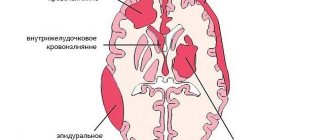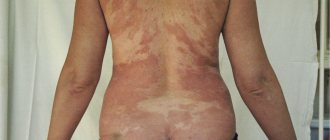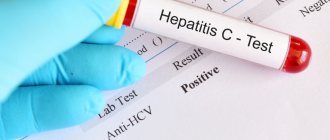General information
The viral disease West Nile fever was first discovered in Uganda in 1937. Today it is widespread on many continents - many outbreaks are recorded in the USA, in the countries of the Mediterranean coast, and the modern form of the virus is also quite common in Indonesia, former CIS countries, in the south of Russia. The pathogen is most viable in tropical and subtropical climates. The disease is transmissible - transmitted by blood-sucking arthropods, in this case mosquitoes, ixodid and argasid ticks. It is seasonal: infection most often occurs from May to October - the period most favorable for the development of mosquitoes.
Virus distribution diagram
The disease is an acute zoonotic disease, also called West Nile encephalitis or duck fever . Distinctive signs are multiple inflammation of the lymph nodes ( polyadenitis ), serous inflammation of the meninges and skin rashes, and in rare cases, meningoencephalitis .
Prevention
No specific vaccine has been developed for West Nile fevers. Nonspecific preventive measures boil down to preventing mosquito bites and ticks, as well as their early removal.
Health education should focus on reducing the risk of mosquito transmission. Efforts to prevent transmission should primarily focus on personal and community protection from mosquito bites through the use of mosquito nets and personal repellents, wearing light-colored clothing (long-sleeved shirts and trousers), and avoiding exposure to outdoors during peak mosquito bite times. In addition, programs should be implemented to encourage communities to eliminate mosquito breeding sites in residential areas.
Pathogenesis
The mechanism of infection after the virus enters the bloodstream occurs along the path of hematogenous dissemination. As a result of viremia, the pathogen is detected in brain tissue. A tropism was revealed not only for neurocytes and cardiomyocytes, but also for vascular endothelial cells.
In response to infection, a perivascular lymphoid infiltrate is formed in the body. Neurocytes undergo dystrophy and necrosis. As a result of vascular damage, edema and swelling of the brain, local and generalized manifestations of thrombohemorrhagic syndrome are aggravated.
The virus is capable of long-term persistence in the human body. After the disease, persistent post-infectious immunity and no repeated cases have been recorded.
Transmission of infection
Infection in humans most often occurs as a result of the bites of infected mosquitoes. Mosquitoes become infected by feeding on the blood of infected birds; the virus circulates in their blood for several days. The virus eventually enters the mosquito's salivary glands. During its subsequent feeding on blood (during mosquito bites), the virus can enter the body of people and animals, where it can multiply and lead to illness. The virus can also be transmitted through contact with other infected animals, their blood or other tissues. A very small proportion of human infections occur through organ transplants, blood transfusions and breastfeeding. One case of transplacental transmission of WNV (from mother to child) has been reported. To date, there are no documented cases of person-to-person transmission of WNV through non-hazardous contacts and no cases of transmission of WNV to healthcare workers when standard infection control precautions are followed.
Causes
The cause of West Nile fever is the spread of an RNA-containing flavivirus, spherical in shape and only 20-30 nm in size.
West Nile virus model
The pathogen is able to survive in frosty and dry conditions; temperatures above 56 degrees Celsius are destructive; ether and deoxycholate are required for inactivation. The reservoir is birds and rodents.
Spreading
The first diagnosis of Nile fever was made in 1999 in Uganda. Until the early 70s, residents of equatorial Africa developed immunity and the virus spread to tropical regions. As a result of tourism, the disease spread to non-tropical regions and was introduced to the United States in 1999. Today, natural foci have been found in the Mediterranean countries, in Armenia, Azerbaijan, Moldova, in southern Ukraine, in the southern European part of Russia and other countries in this strip.
Map of the global spread of West Nile virus
In Russia, the first significant threat was in 1999, when West Nile fever in Volgograd affected more than 700 people, mainly affecting elderly people over 60 years of age, with 9 deaths.
By September 2022, more than 400 cases were registered, which is 2 times more than in previous years, and the disease occurred without symptoms of fever.
Natural foci most often form in suburban areas; they have been identified in the Astrakhan, Rostov, Voronezh, Lipetsk, Saratov and Volgograd regions, Krasnodar and Stavropol Territories, as well as in Tatarstan.
However, due to climate change, there is an increase in outbreaks of the disease. Thus, in Saratov, due to a decrease in the cold period, an increase in precipitation, and an increase in average temperatures, a favorable environment has been created for the development of foci and circulation of West Nile fever viruses. In the Saratov region, Rospotrebnadzor warns of danger and informs about preventive measures - the need to mow weeds, clean and drain basements, eliminate landfills, and install mosquito nets.
When the temperature creeps up
The cause of an increase in body temperature is not always an infectious disease. Tumor cells are also capable of producing endogenous pyrogen, which is most often the cause of fever, rather than the inflammation or decay that accompanies the tumor process. In the case of the non-infectious nature of the disease and the occurrence of aseptic inflammation during mechanical and chemical damage, leukocytes also migrate to the site of damage and produce endogenous pyrogen. In all cases, the mechanism for increasing body temperature is the same. When the diagnosis is clear, the underlying disease is treated and the problem of increased body temperature is resolved simply: the disease has disappeared - body temperature has returned to normal. In these situations, normalization of body temperature is a criterion for recovery.
Symptoms of West Nile fever in humans
From the moment of infection to the appearance of the first symptoms, 3-21 days can pass - this is the duration of the incubation period. The disease in humans begins acutely with hyperthermia (body temperature remains 38-40°) and chills . The fever flares up and then subsides, and can last only 1-2 days, but more often 5-7. Its harbingers are often such short-term phenomena as:
- general weakness;
- lack of appetite;
- increased sweating ;
- myalgia (especially pain in the calf muscles);
- headache.
, serous meningitis occurs . As a result, patients develop a fragmentation of mild meningeal symptoms in the form of stiffness of the neck muscles, Kernig and Brudzinski symptoms, inflammatory changes in the cerebrospinal fluid - the development of pleocytosis , a slight increase in the amount of protein. Focal scattered microsymptoms from the nervous system develop, including horizontal nystagmus , palmomental symptom, diffuse decrease in muscle tone, deterioration of tendon and absence of abdominal reflexes.
Rare encephalitic manifestations are replaced by signs of mixed somato-cerebral asthenia ( sweating , insomnia , general weakness, mental depression, weakened memory are observed), which are caused by West Nile fever. Symptoms of intoxication are expressed as:
- severe painful headache, especially in the forehead and eyes, as well as pain in the neck and lower back;
- pain, discomfort and cardiac arrest;
- pain and swelling of the joints;
- hyperemia of the skin and in 5% of cases – maculopapular rash;
- repeated vomiting, lack of appetite, diarrhea and other dyspeptic disorders;
- hyperemia of the conjunctiva and uniform injection of the vessels of the eyeballs;
- hyperemia and granularity of the mucous membranes of the oral cavity;
- arterial hypotension;
- hepatolienal syndrome;
- polylymphadenitis – peripheral lymph nodes are enlarged, their sensitivity and slight pain;
- in rare cases, the nose becomes stuffy and a dry cough begins.
The clinic is accompanied by minor changes in laboratory parameters - an increase in ESR, slight leukocytosis .
Symptoms of West Nile fever in children often resemble tick-borne encephalitis . The disease is tolerated much more easily by children than by elderly people or people with weakened immune systems.
Diagnosis with test tube and microscope
The problem of LNG affects many areas of medicine and requires the attention of doctors of various specialties. And since the mechanism for increasing body temperature in the vast majority of cases is the same (we will not discuss vague subfebrile conditions, when the body temperature rises no higher than 380C for a long time and in most cases is a consequence of autonomic dysfunction or organic brain damage), then significant difficulties arise in the differential diagnosis of diseases. Selective rather than total screening is recommended. And only an experienced doctor can determine the required scope of examination after analyzing complaints, medical history, and examination results. The specialist will pay attention to paraneoplastic signs, that is, symptoms that may accompany the tumor process - specific changes in the skin, joints, blood vessels (migratory thrombophlebitis). In modern practice, the possibilities of laboratory methods are used - blood testing for specific tumor markers. To clarify the diagnosis, if infectious diseases are suspected, in addition to routine methods, serological and bacteriological tests of blood, urine, feces, and the polymerase chain reaction (PCR) method, which has 100% specificity, are used. To confirm the diagnosis of systemic connective tissue disease, repeated additional laboratory examinations (rheumatoid factor, antibodies to DNA, etc.) may be required. And in order to confirm the syndrome of autonomic dysfunction, that is, functional changes with unclear low-grade fevers, it is also necessary to conduct an examination to exclude a more serious pathology. The issue of treatment for LNG is decided individually in each specific case. In the meantime, the diagnosis is unclear, you should refrain from treatment. Only in cases of poor tolerance and possible complications (in the elderly, children and with concomitant pathologies) are drugs used to reduce body temperature, preferably paracetamol in appropriate doses.
Tests and diagnosis of West Nile fever
The reasons for suspecting West Nile fever are the characteristic clinical picture and epidemiological history.
Serological studies do not provide completely reliable results, since flaviviruses have a close antigenic relationship and the detection of antibodies in blood serum is due to the circulation of another type of virus.
Diagnosis is carried out by isolating MK-2 cells from cultures and intracerebral infection of mice. To identify West Nile virus, fluorescent antibodies and species-specific luminescent immunoglobulins are used.
Laboratory tests of cerebrospinal fluid reveal:
- lymphocytic pleocytosis 100-2000×106/l;
- slight increase in the amount of proteins.
Quality + quantity = the key to successful treatment
Thus, a prolonged increase in temperature is a reason to consult a doctor. In order to complete the examination as quickly as possible with an extremely informative result, it makes sense to contact multidisciplinary medical institutions, which is what CELT is. The combination of an integrated approach to the problem and a high professional level of specialists in specific areas allows the attending physician to be flexible in the choice of remedies. If necessary, doctors of various specialties gather simultaneously, without any bureaucracy, to solve a complex “borderline” problem. But if necessary, literally in the next minute you can “switch” this task to a “narrow” specialist. In the diagnostic and treatment department, in 2-3 days, you can carry out both routine tests, such as clinical blood and urine tests, biochemical blood tests, ultrasound and X-ray diagnostics of various organs, endoscopic studies of the gastrointestinal tract (esophagogastroduadeno- and colonoscopy), and special studies according to indications (blood tests for various infections, hormones, specific tumor markers, immunological studies, rheumatic tests, blood and urine cultures, computed tomography, laparoscopic diagnostics, etc.). All consultations are conducted by competent, highly specialized specialists who are able to correctly interpret research results and either exclude one or another pathology or prescribe effective treatment. But the main advantage of this approach is the participation of a therapist, who combines and summarizes all the information that comes to him about the prescribed treatment and chooses the optimal tactics to combat the disease.








